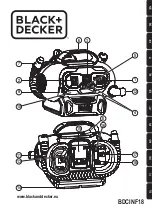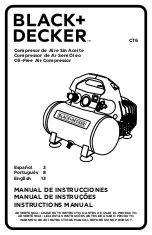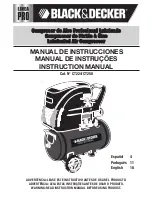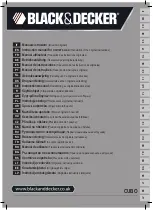
Section 2
DESCRIPTION
10
energizing the 3---way solenoid valve and allowing
the blowdown valve to close. The re---energized so-
lenoid valve again prevents pressure from reaching
the inlet valve. The inlet valve is fully open and the
compressor delivers full rated capacity. Should the
pressure begin to rise, the pressure regulator will
resume its normal function as previously de-
scribed.
To accomodate varied periods of time when there
are not any air requirements, “Dual---Control” is uti-
lized. This feature allows you to set the compressor
in an automatic position whereby the compressor
will shut down when no compressed air require-
ment is present and restart as compressed air is
needed.
2.7 CONTROL SYSTEM,
FUNCTIONAL DE-
SCRIPTION-- SUPERVISOR
II
Refer to Figure 2.3. The purpose of the compressor
Control System is to regulate the amount of air be-
ing compressed to match the amount of com-
pressed air being used. The Capacity control sys-
tem consists of a
solenoid valve
,
regulator valve
and an
inlet valve
. The functional description of the
Control System is described below in four distinct
phases of operation. The following description text
applies to all LS---10 Series compressors with op-
tional Supervisor
II
. For explanatory purposes, this
description will apply to a compressor with an oper-
ating range of 100 to 110 psig (6.9 to 7.6 bar). A
compressor with any other pressure range would
operate in the same manner except stated pres-
sures.
START MODE -- 0 TO 50 PSIG (0 TO 3.5 BAR)
When the compressor
“I” (START)
pad is de-
pressed, the sump pressure will quickly rise from 0
to 50 psig (0 --- 3.4 bar). The compressor initially
starts unloaded, then switches to full load when full
rpm has been achieved. During this period, both
the pressure regulator and the solenoid valve are
closed, the inlet valve is fully open and the com-
pressor pumps at full rated capacity. The rising
compressor air pressure is isolated from the ser-
vice line in this phase by the minimum pressure
valve set at approximately 50 psig (3.4 bar).
FULL LOAD MODE -- 50 TO 100 PSIG (3.4 TO 6.9
BAR)
When the compressed air pressure rises above 50
psig (3.4 bar), the minimum pressure valve opens
allowing compressed air to flow into the service
line. From this point on, the line air pressure is con-
tinually monitored by the Supervisor. The pressure
regulator and the solenoid valve remain closed dur-
ing this phase. The inlet valve is in the fully open
position as long as the compressor is running at
100 psig ( 6.9 bar) or below.
MODULATING MODE -- 100 TO 110 PSIG (6.9
TO 7.6 BAR)
If less than the rated capacity of compressed air is
being used, the service line pressure will rise above
100 psig (6.9 bar). The pressure regulator valve
gradually opens, directing air pressure to the inlet
control valve, reducing air entering the compressor
until it matches the amount of air being used. The
control system functions continually in this manner
between the limits of 100 to 110 psig (6.9 to 7.6 bar)
in response to varying demands from the service
line.
The pressure regulator has an orifice which vents a
small amount of air to the atmosphere when the
pressure regulator controls the inlet control valve.
The orifice also bleeds any accumulated moisture
from the pressure regulator.
UNLOAD MODE -- IN EXCESS OF 110 PSIG (7.6
BAR)
When a relatively small amount or no air is being
used, the service line pressure continues to rise.
When it exceeds 110 psig (7.6 bar), the Supervisor
Control System de---energizes the solenoid valve
allowing sump air pressure to be supplied directly
to close the inlet valve. Simultaneously, the sole-
noid valve sends a pneumatic signal to the blow-
down valve. The blowdown valve opens to the at-
mosphere, reducing the sump pressure to approxi-
mately 25 to 27 psig (1.7 to 1.9 bar). The check
valve in the air service line prevents line pressure
from returning to the sump.
When the line pressure drops to the low setting
(cut---in pressure; usually 100 psig [6.9 bar] on low
pressure [“L”] compressors and 115 psig [8.0 bar]
on high pressure [“H”] compressors, 140 psig [9.7
bar] on [“HH”] compressors, 175 psig [12.0 bar]
[“XH”] . Supervisor energizes the solenoid valve
and allows the blowdown valve to close. The re---
energized solenoid valve again prevents line pres-
sure from reaching the inlet control valve. Should
the pressure begin to rise, the pressure regulator
will resume its normal function as previously de-
scribed.
AUTOMATIC OPERATION
For applications with varied periods of time when
there are no air requirements, Supervisor’s AUTO-
MATIC mode allows the compressor to shutdown
(time delayed) when no compressed air require-
ment is present and restart as compressed air is
needed.
2.8 AIR INLET SYSTEM, FUNCTIONAL DE-
SCRIPTION
Refer to Figure 2---4. The Compressor Inlet System
consists of a
dry--type air filter
, a
restriction
gauge
and an
air inlet valve
.
The restriction gauge (located on the instrument
panel), indicates the condition of the air filter by
showing red when filter maintenance is required.
The poppet---type modulating air inlet valve directly
controls the amount of air intake to the compressor
in response to the operation of the pressure regula-
tor (see Modulating Mode, Section 2.6 [Standard
Electrol/Mechanical] or Section 2.7 [Optional Su-
pervisor
Il
]). The inlet valve also acts as a check
Summary of Contents for LS-10 18KW 24KT
Page 6: ...NOTES...
Page 15: ...Section 2 DESCRIPTION 9 Figure 2 3 Control System...
Page 18: ...12 NOTES...
Page 22: ...16 NOTES...
Page 26: ...20 NOTES...
Page 34: ...28 NOTES...
Page 38: ...32 NOTES...
Page 48: ...Section 7 MAINTENANCE 42 Figure 7 7 Piping and Instrumentation Diagram Standard...
Page 49: ...Section 7 MAINTENANCE 43 Figure 7 8 Piping and Instrumentation Diagram Supervisor II...
Page 50: ...44 NOTES...
Page 52: ...Section 8 ILLUSTRATIONS AND PARTS LIST 46 8 3 MOTOR COMPRESSOR FRAME AND PARTS...
Page 54: ...Section 8 ILLUSTRATIONS AND PARTS LIST 48 8 3 MOTOR COMPRESSOR FRAME AND PARTS...
Page 56: ...Section 8 ILLUSTRATIONS AND PARTS LIST 50 8 4 COOLER ASSEMBLY...
Page 58: ...Section 8 ILLUSTRATIONS AND PARTS LIST 52 8 5 AIR INLET SYSTEM...
Page 60: ...Section 8 ILLUSTRATIONS AND PARTS LIST 54 8 6 COOLING AND LUBRICATION SYSTEM...
Page 62: ...Section 8 ILLUSTRATIONS AND PARTS LIST 56 8 6 COOLING AND LUBRICATION SYSTEM...
Page 68: ...Section 8 ILLUSTRATIONS AND PARTS LIST 62 8 8 CONTROL SYSTEM AND ELECTRICAL PARTS...
Page 70: ...Section 8 ILLUSTRATIONS AND PARTS LIST 64 8 8 CONTROL SYSTEM AND ELECTRICAL PARTS...
Page 72: ...Section 8 ILLUSTRATIONS AND PARTS LIST 66 8 9 INSTRUMENT PANEL...
Page 76: ...Section 8 ILLUSTRATIONS AND PARTS LIST 70 8 11 DECAL GROUP 1 2 3 4 5 6 7 8 9 10 11...
Page 78: ...Section 8 ILLUSTRATIONS AND PARTS LIST 72 8 11 DECAL GROUP 12 13 14 15 16 17 18 19 20...
Page 80: ...Section 8 ILLUSTRATIONS AND PARTS LIST 74 8 11 DECAL GROUP 21 22 23 24 25 26 27...
Page 82: ...Section 8 ILLUSTRATIONS AND PARTS LIST 76 8 11 DECAL GROUP ADD FULL 29 28 30 31...
Page 88: ...NOTES...
Page 89: ...NOTES...
















































